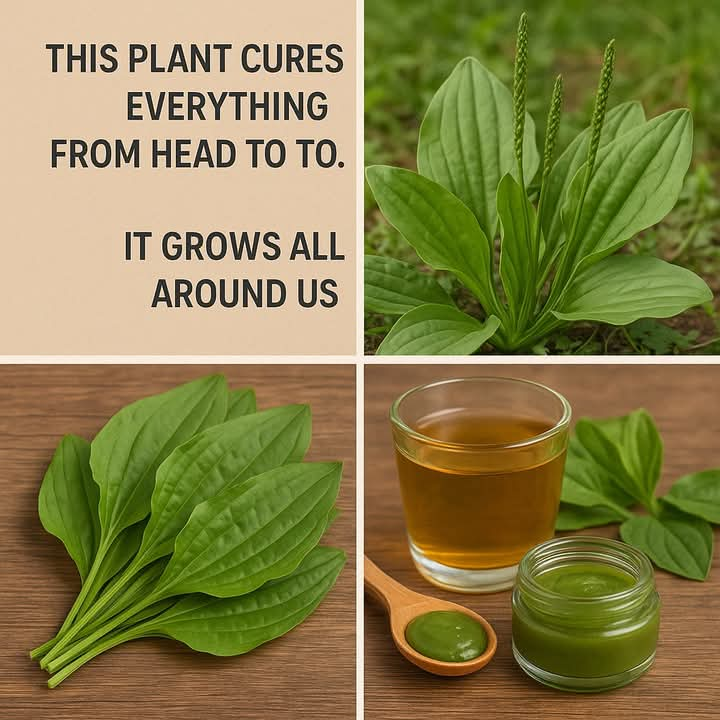Sure! Here’s a complete article-style piece on Plantago major following your structure and tone, without numbered points:
Introduction
Plantago major, commonly known as broadleaf plantain, is a powerful medicinal herb that grows freely in lawns, gardens, roadsides, and open fields.
Though often dismissed as a common weed, this humble plant holds extraordinary healing potential.
For centuries, traditional medicine has valued it for its impressive ability to address a wide range of health issues, from surface wounds to internal inflammation.
Ingredients
To prepare Plantago major for various remedies, fresh or dried leaves are typically used. You’ll need organic Plantago major leaves, preferably harvested away from roads or sprayed areas.
Supporting ingredients might include olive oil, beeswax, apple cider vinegar, honey, or other herbs like calendula, comfrey, or lavender depending on the desired use. Pure water or alcohol can be used for extracts or tinctures.
Instructions
Begin by identifying and harvesting healthy, vibrant leaves. Look for rich green, broad leaves that are free from pests or damage.
It’s best to collect them early in the morning when their medicinal oils are at their peak.
Wash the leaves gently to remove dirt and impurities. Pat them dry with a clean towel or let them air dry naturally to preserve their properties.
For drying, spread the leaves in a single layer on a clean surface in a shaded, ventilated area. This step is important if you plan to store them long-term or use them in oil infusions.
If you’re using them fresh, chop or bruise the leaves slightly to release their healing juices before applying them directly to the skin or mixing into preparations.
To make a basic infusion, place fresh or dried leaves in boiling water, cover, and let steep for 10 to 15 minutes. Strain before drinking or using externally as a wash.
You can also steep the leaves in a carrier oil like olive oil over low heat or in sunlight over several weeks to extract their healing compounds for use in salves or ointments.
Store any prepared remedy in a clean, airtight jar in a cool, dark place. Label with the date and ingredients for future reference.
How to Make
To make a soothing salve, start by infusing dried Plantago major leaves in olive oil. Gently heat the mixture using a double boiler or warm sunlight for a few hours or days to draw out the plant’s properties.
Once your oil is infused, strain out the plant material and return the oil to the pot. Add beeswax and heat gently until melted, stirring constantly.
Pour the mixture into small jars or tins and allow it to cool and solidify. This salve is excellent for cuts, insect bites, rashes, and skin irritations.
For a healing tea, steep a handful of fresh or a tablespoon of dried leaves in hot water. Drink warm to ease digestive issues, sore throats, or urinary discomfort.
A tincture can be made by covering chopped leaves in a jar with alcohol (like vodka) and letting it sit for several weeks. Shake daily and strain after four to six weeks for a concentrated extract.
A poultice can be made by crushing fresh leaves and applying them directly to wounds or stings, then covering with a clean cloth.
For a skin rinse, boil the leaves and allow the water to cool. Use as a gentle, healing wash for acne, eczema, or scalp irritations.
Variations
You can blend Plantago major with other herbs to enhance its benefits. Calendula adds extra anti-inflammatory properties, while comfrey supports tissue repair.
Adding lavender or chamomile can improve scent and add a calming effect to teas or salves.
Combine Plantago with honey for a soothing cough syrup, letting both steep in warm water before cooling and storing.
Use coconut oil instead of olive oil for a lighter-feeling salve, especially in warmer climates where heavier oils may feel too thick.
Create a cooling gel by mixing Plantago tea with aloe vera and storing in the fridge—perfect for sunburns or rashes.
Mix dried, powdered leaves with bentonite clay and water to create a detoxifying face or body mask.
Make a flavored tonic by steeping leaves in apple cider vinegar, optionally adding garlic or herbs for added benefits and taste.
Tips
Always harvest your Plantago major from clean, unsprayed areas. Urban or roadside plants may be contaminated with pollutants.
Use fresh leaves when possible for the most potent remedies, especially for poultices and tea.
Label your homemade remedies with ingredients and date to keep track of potency and freshness.
If storing dried leaves, keep them in a sealed container away from light and moisture to preserve their healing properties.
Test salves and tinctures on a small patch of skin before broader application, especially if you have sensitive skin or allergies.
Rotate your remedies seasonally—make oil infusions in summer, tinctures in fall, and store salves for winter use.
Share your remedies with others! Plantago is gentle and suitable for all ages, making it a wonderful introduction to herbal medicine.
Conclusion
Plantago major is a remarkable example of nature’s generosity. Growing underfoot and often unnoticed, it offers powerful support for both internal and external healing. From wounds to digestion, its wide range of uses makes it an essential herb to know and keep on hand.
By reconnecting with simple, time-tested plants like Plantago, we nurture not only our bodies but also a deeper awareness of the natural world. This humble herb is proof that sometimes, the best medicine is already growing all around us.
Let me know if you’d like this formatted for a blog post, printable recipe card, or anything else!
